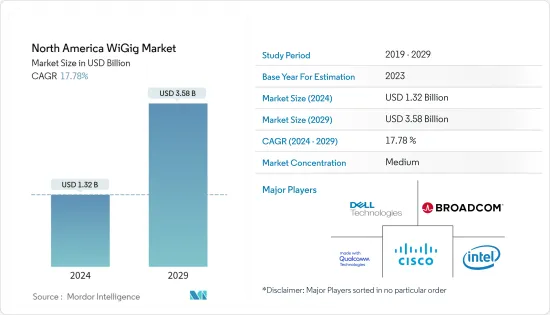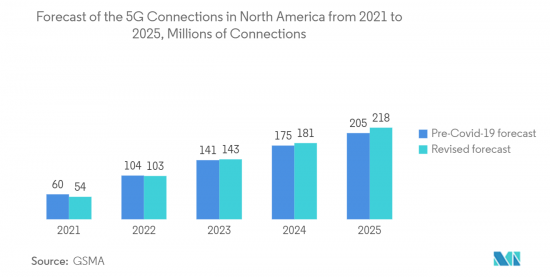PUBLISHER: Mordor Intelligence | PRODUCT CODE: 1403898

PUBLISHER: Mordor Intelligence | PRODUCT CODE: 1403898
North America WiGig - Market Share Analysis, Industry Trends & Statistics, Growth Forecasts 2024 - 2029

The North America WiGig Market size is estimated at USD 1.32 billion in 2024, and is expected to reach USD 3.58 billion by 2029, growing at a CAGR of 17.78% during the forecast period (2024-2029).
Key Highlights
- The WiGig market is primarily driven by the increasing demand for high-speed, data-intensive connections in various applications such as virtual reality, multimedia streaming, gaming, wireless docking, and enterprise applications in the North American region.
- The high internet penetration, along with large smartphone users in the region driven by the United States and Canada, is expected to drive the demand for Wi-Fi with high speed in gigabytes using WiGig. North America is quickly migrating toward multi-gigabit, residential internet access, primarily using fiber to the home. The economic feasibility of extracting more bandwidth from existing networks using DOCSIS 3.1 is trending with the real opportunity of wireless and speed, by which the demand for WiGig is increasing in this region.
- The quality of consumers' experience is also improving as a result of technological progress. The WiGig market is expected to grow further as demand for ultrahigh definition videos, films, and video-on-demand services increases. Virtual Reality and Augmented Reality in gaming are also expected to boost the growth of this market.
- The advent of the Internet of Things, i.e., IoT and machine communication MTC, has led to exponentially growing mobile traffic in recent years.
- The disadvantage associated with Wi-Fi is that this technology has a limited range compared with the current use of Wi-Fi. The use of the 60GHz spectrum for WiGig means that a signal cannot be transmitted to walls, although it is effective in small and targeted areas. It is necessary to use multiple access points in order to remedy the lack of range available for WiGig connections in densely populated areas, but this also means that each Access Point should function on an individual basis with a view to preventing network traffic.
- With the outbreak of the COVID-19 pandemic in various countries of the North American region, the majority of these vendors' functions are disrupted. This halted the manufacturing operations of these companies and affected the global supply network, which negatively impacted the market. Moreover, the work-from-home policies during the pandemic positively influenced the demand for WiGig for network requirements in various devices such as mobile phones, laptops, tablets, desktops, etc.
North America WiGig Market Trends
Networking to Hold a major share of the Market
- The WiGig technology supports direct mode, which means the home, enterprises, and service providers are switching to a network for the replacement of cables as well as infrastructure networking. This is a critical point when WiGig in the 2.4 GHz and 5Ghz bands 802.11n and ac would be able to move around dynamically from conventional WiFIs into or across the triband connectivity network. That's a big feature because there are likely to be gaps in coverage of WiG when it comes out into the house.
- Moreover, The WiGig market could offer opportunities for growth due to the increasing number of Internet of Things devices. However, it leads to significant overhead costs, high energy consumptions, and low throughput of WiGig2D networks in the use of direct beamforming training during DND2D neighbor discovery.
- North America has been extensively investing in its 5G infrastructure in order to cover most remote places. The use of a 60GHz band has a vital importance in 5G network scaling and can be densified through the addition of small-cell wireless backhaul. In comparison with a fiber connection, WiGig has a cost-effective advantage by using wireless small-cell backhaul.
- The development of WiGig chipsets was a collaboration between Intel and SK Telecom. Both companies have joined forces to advance their efforts with the Anchorbooster Cell technology, which they state as one of the key technologies for 5G that allows seamless transmission of large amounts of data through a combination of LTE and WiGig networks. The two companies have also mentioned that they would apply Mobile Edge Computing technology on the anchor-booster cell to enhance the quality of experience further and to enable the development of new business models for enterprises and critical verticals.
Given the significant decrease in the count of connected devices and personal computers observed in previously high-traffic areas, it is evident that the impact of the COVID-19 pandemic on telecommunications services and traffic is noteworthy. As a result of people staying at home and the surge in remote work, there has been a reduction in the number of connected mobile devices and PCs, with a simultaneous increase in the utilization of home Wi-Fi networks by American consumers.

United States to Hold the Highest Market Share
- In order to cover the majority of these isolated areas, the region is investing heavily in its 5G infrastructure. The 60 GHz band has a pivotal role to play in the deployment of 5G networks and can also be made densable by adding small cell wireless backhaul. Compared to the fiber connections, WiGig's cost-effectiveness is due to its use of Wireless Small Cell backhaul.
- Furthermore, the market for wireless streaming of content to high-resolution televisions or other monitors in a room is being stimulated by the consumer electronics sector as mobile phones, tablets, and computers could connect with WiGig. For instance, if you have an Asus ROG phone with a display dock that's capable of wireless connectivity to large-screen TVs, WiGig can be used. The TwinView dock is equipped with a 6.59-inch TFT touchscreen, 120Hz touchscreen, a 2nd massive 5,000 mAh battery, and an air conditioning unit.
- The high internet penetration, along with large smartphone users in the region driven by the United States, is expected to drive the demand for Wi-Fi with high speed in gigabytes using WiGig. North America is quickly migrating toward multi-gigabit, residential internet access, primarily using fiber to the home. The economic feasibility of extracting more bandwidth from existing networks using DOCSIS 3.1 is trending with the real opportunity of wireless and speed, by which the demand for WiGig is increasing in this region.
- In addition, the FCC stated that in order to create a 5G network, there must be at least 800,000 RF antennas set up throughout the country, three times as large as what is currently available. This indicates that in the forecast period, there may be an opportunity to install WiGig chips for 5G network expansion across the region.
North America WiGig Industry Overview
The North American WiGig market is moderately fragmented due to the presence of several major vendors that currently hold significant market share. Key players in this market include Google, Facebook, Intel, Infineon, Qualcomm, and others.
In September 2023, Peraso Inc. announced the release of the PRM2144X, the latest mmWave module in the company's PERSPECTUS series. This module is designed for long-range outdoor applications and incorporates Peraso's intelligent Media Access Control features. The PRM2144X empowers wireless Internet service providers (WISPs) to deploy long-range, multi-point networks in dense user environments without concerns about interference.
In September 2022, Intel Corporation and Broadcom Inc. jointly announced the industry's first cross-vendor Wi-Fi 7 demonstration. This demonstration showcased over-the-air speeds exceeding 5 gigabits per second. Wi-Fi 7 leverages innovative features, such as wider 320 MHz channels in the unlicensed 6GHz spectrum, higher order 4K QAM data modulation, simultaneous connections across multiple bands with multi-link operation, and improved channel utilization efficiency with multi-resource unit puncturing.
Additional Benefits:
- The market estimate (ME) sheet in Excel format
- 3 months of analyst support
TABLE OF CONTENTS
1 INTRODUCTION
- 1.1 Study Assumptions and Market Definition
- 1.2 Scope of the Study
2 RESEARCH METHODOLOGY
3 EXECUTIVE SUMMARY
4 MARKET INSIGHTS
- 4.1 Market Overview
- 4.2 Industry Attractiveness - Porter's Five Forces Analysis
- 4.2.1 Threat of New Entrants
- 4.2.2 Bargaining Power of Buyers/Consumers
- 4.2.3 Bargaining Power of Suppliers
- 4.2.4 Threat of Substitute Products
- 4.2.5 Intensity of Competitive Rivalry
- 4.3 Technology Snapshot
5 MARKET DYNAMICS
- 5.1 Market Drivers
- 5.1.1 Growing Technological Advancement in Communication Industry
- 5.1.2 Rising Adoption of High-resolution Videos
- 5.2 Market Restraints
- 5.2.1 Shorter Operating Range of WiGig Products
6 MARKET SEGMENTATION
- 6.1 Product
- 6.1.1 Display Devices
- 6.1.2 Network Infrastructure Devices
- 6.2 Application
- 6.2.1 Gaming and Multimedia
- 6.2.2 Networking
- 6.2.3 Other Applications
- 6.3 Country
- 6.3.1 United States
- 6.3.2 Canada
7 COMPETITIVE LANDSCAPE
- 7.1 Company Profiles
- 7.1.1 Qualcomm Technologies Inc.
- 7.1.2 Intel Corporation
- 7.1.3 Broadcom Inc.
- 7.1.4 Cisco Systems Inc.
- 7.1.5 Dell Technologies Inc.
- 7.1.6 Lenovo Group Limited
- 7.1.7 HP Development Company LP
- 7.1.8 Tensorcom Inc.
8 INVESTMENT ANALYSIS
9 FUTURE OF THE MARKET




